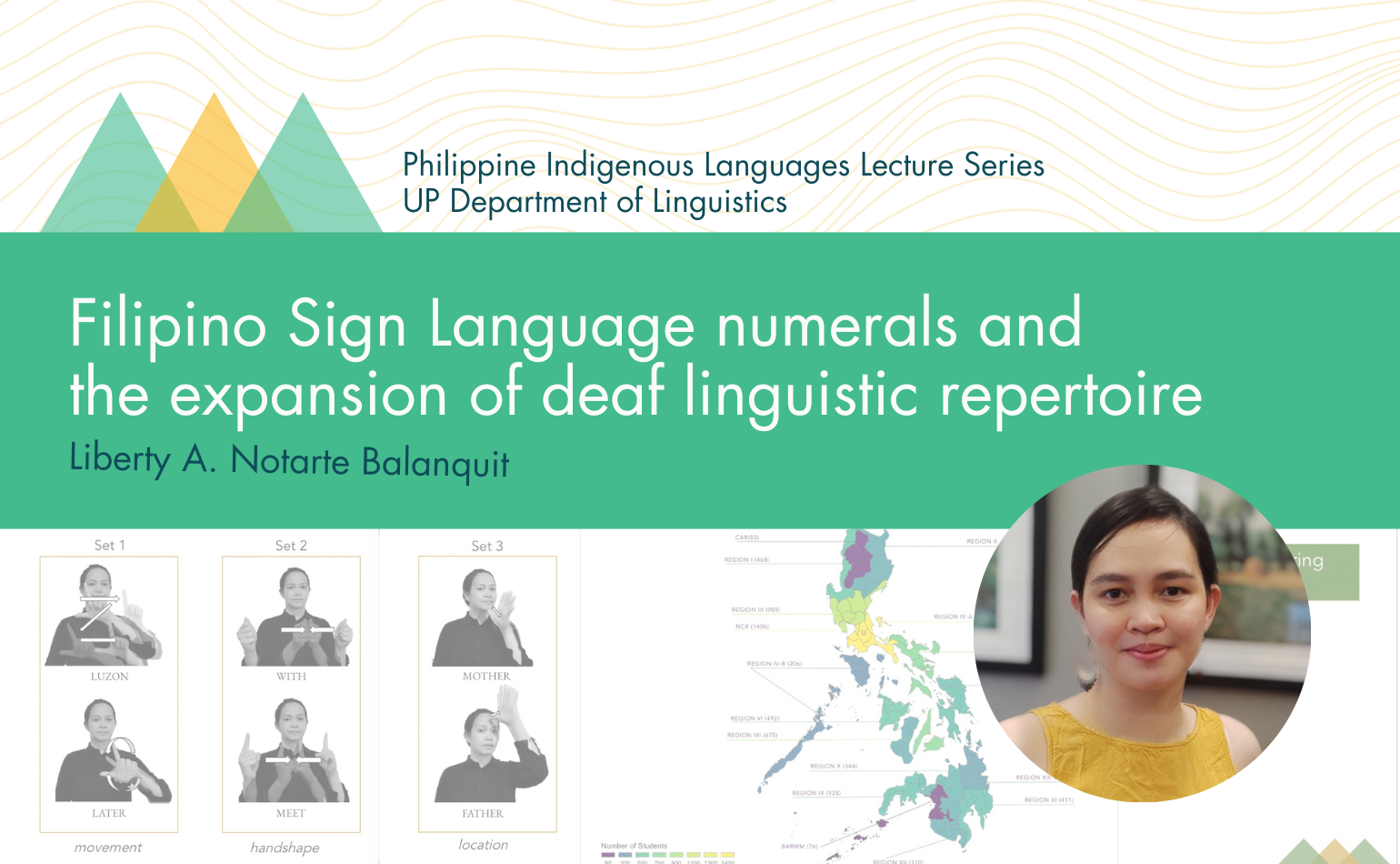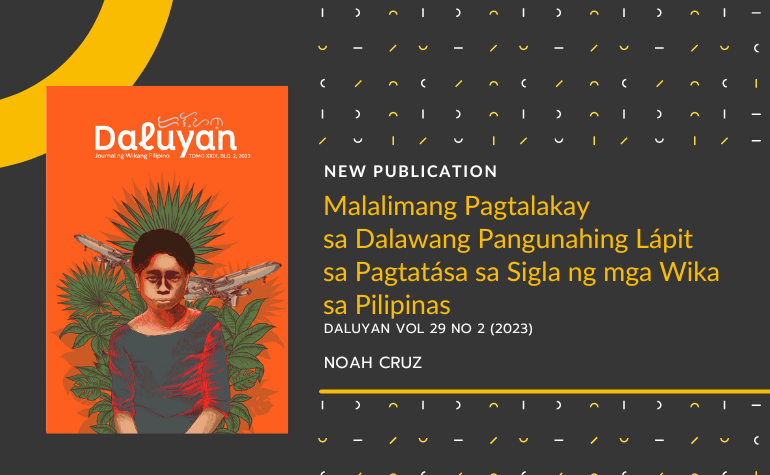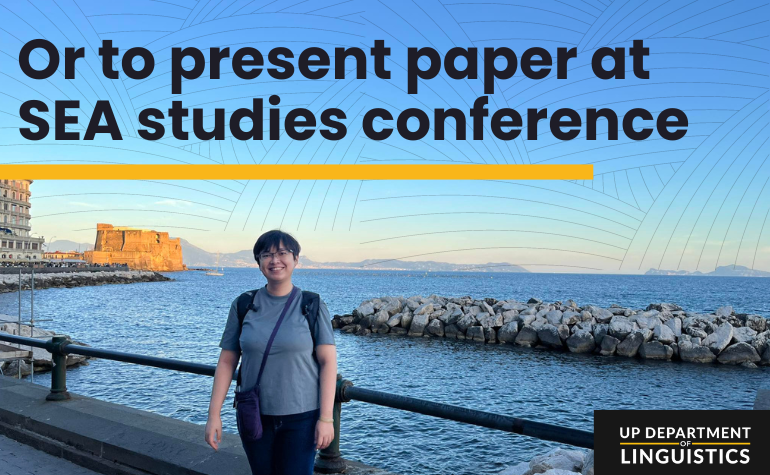
The seventh installment of the 2023 Philippine Indigenous Languages Lecture Series (PILLS) featured MA Ling alum Asst. Prof. Liberty Notarte-Balanquit (UP Los Baños) who talked about Filipino Sign Language numerals and the expansion of the deaf linguistic repertoire. Notarte-Balanquit’s presentation is part of her ongoing PhD project, “Constraints on Filipino Sign Language Variation: typological and sociolinguistic perspectives.” The webinar, which aired last July 17, can be viewed on the Department’s YouTube channel.
Filipino Sign Language (FSL) is the national sign language of the Philippines, legally recognized in 2018 through The Filipino Sign Language Act. It is characterized as an understudied deaf community sign language in Southeast Asia, whose varieties are found at the national, local (community), and domestic (home) levels.
The Philippine Statistics Authority (PSA) estimates that there are 1,784,690 individuals with hearing difficulty in 2020. They belong to different communities across the country and are mostly born to hearing families within which they learn to use home signs. Deaf children acquire FSL formally in elementary school, engaging in both deaf-to-deaf and deaf-to-hearing interactions. The prevalence of negative attitudes towards deafness is not surprising. Oftentimes, deaf children are made to adjust to a hearing environment. Notarte-Balanquit thus underscored the need for a change: “We want to give the Filipino Deaf Community an education that is based on their language… And we want to recognize that Filipino Sign Language is part of their deaf identity, and this is one of the reasons why research on the structure of Filipino Sign Language and variation of FSL is urgent and necessary.”
At present, she is annotating her data collected last year from 120 signers from Palawan, Samar-Leyte, and southern Mindanao for statistical analysis. A part of her research focuses on how numbers and negation are signed in FSL. She remarked that the variation in FSL numerals stems from three reasons: (1) the availability of iconic signs; (2) FSL’s history of contact with other languages; and (3) the different interlocutors that signers interact with.
Iconicity refers to either the hands mimicking the shape of written numbers, or the cumulative addition of fingers onto the hands. There are also different strategies in which numerals are formed in sign languages (as illustrated below). Lexical strategy refers to a particular handshape representing a number (e.g. ‘10’ in Japanese Sign Language). Sequential strategy involves a sequence of handshapes representing morphological elements (e.g. 15‘ in Ugandan Sign Language). Simultaneous strategy refers to a numeral handshape accompanied by a movement (e.g. ‘20’ in Estonian Sign Language).

Meanwhile, methods used to elicit data include money counting, object counting, and guessing the price. Data collected were coded based on morphological parameters (i.e. one-handed, two-handed, simultaneous, sequential) and numeral operations (i.e. additive base, multiplicative base).
Notarte-Balanquit explained some of her observations regarding the variation in numeral strategies. First, signers use a combination of the strategies of numeral formation. Examples include less iconic signs for ‘6–10,’ as borrowed from American Sign Language (ASL); the lexical basis for ‘100’ (i.e. sign for ‘1’ and a ‘C’) and ‘1000’ (i.e. palm touch); initialism for ‘million’ (i.e. ‘M’ + palm touch); and the simultaneous movements for ‘16–19,’ which are variants from ASL. Second, larger numbers utilize more choices of features and combinations, and thus produce more variation within the community, or even among individuals. And third, signed numerals can be broadly categorized based on their morphological transparency or the way in which the components in the numeral dimension are morphologically realized.
She then expounded that the primary sociolinguistic motivations causing the variation are: (1) borrowing and contact with other languages (e.g. ASL); and (2) the interlocutor effect, where certain signs are used depending on who the signers are communicating with. In terms of retention, she noted that both vertical (i.e. historical) and horizontal (i.e. from around the community) influences lead to the generation of different ways of signing numerals.
Notarte-Balanquit ended her talk by emphasizing that FSL research is relevant to a variety of topics concerning education, literacy, and behavior. She expressed her hope that her current project can contribute to the emerging field of Filipino Sign Language research and that more Filipinos would take interest in conducting similar studies in the future.
The discussion continued during the open forum where questions about data processing and notation system, prospects of dialectal variation, and mutual intelligibility were raised by audience members. She also shared that she is currently building a reference website for FSL, which can hopefully help educators in teaching the language.
Pagpupugay sa inyong makabuluhang pananaliksik! Thank you also to Ms. Sarah Jael Cortez and Mr. Bryan Pepito who served as FSL interpreters for this lecture.
Published by Patricia Anne Asuncion



